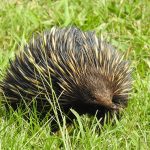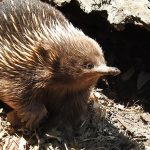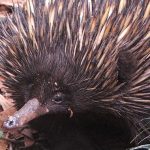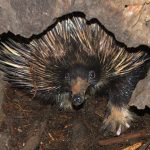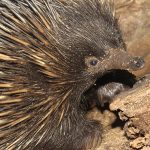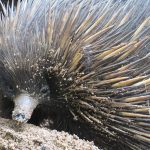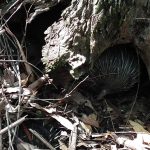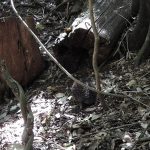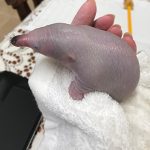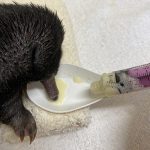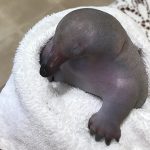ECHIDNA
Australia’s Echidna: The Quiet Marvel of the Bush
On a cool afternoon after rain, the bush smells of damp earth and crushed eucalyptus leaf. From the base of a fallen log comes a soft snuffling, then a faint scratch-scratch. A round little figure waddles into view, dark fur peppered with golden spines. It pauses, lifts a narrow snout to taste the air, and then—tongue flicking like a pink ribbon—vanishes nose-first into the leaf litter. You’ve just met one of Australia’s most extraordinary mammals: the echidna.
Meet the echidna
- Species:Short beaked Echidna (Tachyglossus aculeatus)
- Family: The echidna is a monotreme, one of only five egg-laying mammals on Earth (the others are the Platypus and three long-beaked echidna species of New Guinea).
- Name origins:
Tachyglossusmeans “fast tongue”, a lovely nod to the echidna’s feeding style.
Short-beaked echidnas live across mainland Australia and Tasmania, from beaches and woodlands to arid deserts and snowy ranges. They’re adaptable, ancient, and quietly brilliant.
Built for survival
- Armour and fur: Their spines are modified hairs—rigid, pale-tipped quills set in a coat of coarse, dark fur. When threatened, they curl tight or dig down, presenting a bristling shield.
- Digging machine: Powerful forelimbs and shovel-like claws rip into soil and logs. The hind feet point slightly backwards, handy for grooming between spines and pushing soil when they “anchor” themselves.
- The beak: A soft, flexible snout houses keen smell and touch—and a small number of electroreceptors that sense faint electrical signals from prey in soil.
- Tongue and teeth: No teeth. Instead, a long, sticky tongue flicks rapidly to snare ants, termites and beetle larvae, which are then crushed against hard keratin pads in the mouth.
- Cool customer: Echidnas have a low body temperature (about 31–32°C) and a slow metabolism. They slip into
torpor—a short, energy-saving sleep—on cold days or during heat or food shortages. In cooler regions, some hibernate for weeks to months.
Daily life and diet
Listen for soft snorts and the rustle of leaf litter. Echidnas forage with a deliberate, nose-to-ground shuffle, tearing into termite mounds or rotting wood. They’re mostly solitary and have excellent hearing and smell. In hot areas they are more active at dawn, dusk or night; in cool places they wander by day, soaking up gentle sun on rock or log.
What they eat:
- Ants and termites
- Beetle larvae and other soil invertebrates
- Occasionally worms and other small prey
They’re also strong swimmers, paddling with head held just above the surface and their snout acting like a little snorkel.
The Echidna’s Unique Breeding Season
Unlike marsupials, Echidnas don’t have a permanent pouch. Instead, the mother creates a temporary fold of skin to protect her egg. When the time comes, she lies on her back and gently guides the egg into this makeshift pouch.
Within just 10 days, the egg hatches and out comes a Puggle – blind, hairless, and entirely dependent on its mother.
From Egg to Puggle: A Rare Mammal Story
The first days of life are remarkable:
- The Puggle hatches using its egg tooth – the only tooth it will ever have.
- It stays in the mother’s pouch for around 50 days, feeding on nutrient-rich milk.
- Once its sharp spines begin to grow, the mother moves it into a nursery burrow.
- She visits every 5–6 days to feed it until it’s strong enough to survive alone.
Fun fact: Echidna milk contains powerful antimicrobial properties, sparking scientific research into new medical treatments.
Echidna Courtship: The Famous “Echidna Train”
One of the more curious winter spectacles is the Echidna train – where several males follow a single female for days or even weeks, vying for her attention. This endurance contest often leaves males losing a significant amount of body weight.
Echidnas and Their Environment
These incredible monotremes have evolved to survive across much of Australia:
- Low body temperature: about 32–33°C, helping them survive in cool conditions.
- Swimmers and burrowers: they dig quickly to escape threats and use waterholes to stay cool in summer.
- Remarkable memory and intelligence: research shows Echidnas are excellent problem-solvers.
Helping Echidnas in the Wild
How you can help
- Drive mindfully, especially at dawn and dusk, and near termite mounds or bush edges.
- Keep dogs on lead in bushland and secure pets at night.
- Retain fallen logs, leaf litter and native plants in your garden; these shelter the insects echidnas need.
- If you find an echidna crossing a road, give it space. Do not try to pick it up by the spines. If it’s injured, contact a licensed wildlife carer.
- Fence thoughtfully: low-strung wires and tight mesh can trap wildlife. Leave ground gaps where safe to do so.
Sadly, dogs and motor vehicles now pose the biggest risk to Echidnas. Their slow pace makes road-crossings dangerous, and frightened Echidnas instinctively burrow into the ground, rather than fleeing.
👉 What you can do if you find one:
- Never relocate an Echidna – they have strong site loyalty and will try to return, crossing unsafe terrain.
- Keep pets and curious humans away until the animal feels safe to move on.
- If you find an injured Echidna, or one struck by a car, check the area for a Puggle – they may have rolled away and appear like a small, smooth clay ball. Wrap gently (no heat) and contact a registered Wildlife care organisation immediately.
Why Echidnas Matter
The Echidna’s story reminds us of the fragile balance between wildlife and human activity. With lifespans of over 50 years, these creatures represent resilience, adaptation, and evolutionary marvel.
By respecting their habitats and being mindful on the roads, we play a key role in ensuring their survival across Australia’s diverse landscapes.
From the hatching of a tiny Puggle to the determined march of the Echidna train, these monotremes are a marvel of nature. Their survival depends not just on their extraordinary adaptations, but also on how we humans choose to live alongside them.
Quick facts
| Topic | Detail |
|---|---|
| Scientific name | Tachyglossus aculeatus |
| Group | Monotreme (egg-laying mammal) |
| Size | About 30–45 cm long; 2–7 kg (Tasmanian animals often heavier) |
| Diet | Ants, termites, beetle larvae, other invertebrates |
| Defence | Spines, curl-and-dig, powerful claws |
| Senses | Excellent smell; sensitive snout with some electroreception |
| Reproduction | 1 egg; puggle raised in pouch then nursery burrow |
| Lifespan | Often >20 years; up to 40–50 years recorded |
| Distribution | All of Australia, including Tasmania |
| Legal status | Protected native species in all states and territories |


